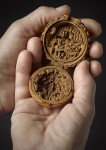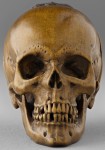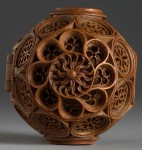 The Art Gallery of Ontario (AGO), in collaboration with the Metropolitan Museum of Art and the Rijksmuseum, is hosting a groundbreaking exhibition that explores the mysterious beauty of 16th century miniature boxwood carvings. The AGO is home to the Thomson Collection of European Art which includes 12 boxwood carvings (10 prayer beads and two altarpieces), the largest collection in one place. There are only 135 known miniature boxwood carvings known to survive, so the AGO has almost 10 percent of the world’s total. Small Wonders: Gothic Boxwood Miniatures brings together the Thomson Collection pieces with another 50 loaned by other museums and private collections.
The Art Gallery of Ontario (AGO), in collaboration with the Metropolitan Museum of Art and the Rijksmuseum, is hosting a groundbreaking exhibition that explores the mysterious beauty of 16th century miniature boxwood carvings. The AGO is home to the Thomson Collection of European Art which includes 12 boxwood carvings (10 prayer beads and two altarpieces), the largest collection in one place. There are only 135 known miniature boxwood carvings known to survive, so the AGO has almost 10 percent of the world’s total. Small Wonders: Gothic Boxwood Miniatures brings together the Thomson Collection pieces with another 50 loaned by other museums and private collections.
 The miniature boxwood carvings were made during a very brief window, between 1500 and 1530, in Flanders or the Netherlands. It’s possible that only a single workshop, perhaps two, carved them all. The rise of a new moneyed merchant class with money to spend on expensive and showy objects created a market for high-end, portable religious carvings. Come the Reformation, rosaries, altarpieces and beads would go most decidedly out of fashion in Northern Europe and the window shut.
The miniature boxwood carvings were made during a very brief window, between 1500 and 1530, in Flanders or the Netherlands. It’s possible that only a single workshop, perhaps two, carved them all. The rise of a new moneyed merchant class with money to spend on expensive and showy objects created a market for high-end, portable religious carvings. Come the Reformation, rosaries, altarpieces and beads would go most decidedly out of fashion in Northern Europe and the window shut.
 The prayer beads, also known as prayer nuts because their exteriors resemble a very symmetrical walnut shell, were devotional objects worn on a belt or on the end of rosary. About the size of golf balls, the beads open to reveal intricate, deeply layered Biblical scenes and inscriptions from the Vulgate. Their rich imagery and detail were meant to inspire contemplation and prayer. They had the ancillary benefit of being a religiously correct way to show off one’s wealth. A dense wood like boxwood holds its shape well and gives
The prayer beads, also known as prayer nuts because their exteriors resemble a very symmetrical walnut shell, were devotional objects worn on a belt or on the end of rosary. About the size of golf balls, the beads open to reveal intricate, deeply layered Biblical scenes and inscriptions from the Vulgate. Their rich imagery and detail were meant to inspire contemplation and prayer. They had the ancillary benefit of being a religiously correct way to show off one’s wealth. A dense wood like boxwood holds its shape well and gives  carvers the opportunity to create tiny details, but it also takes a huge amount of work and time. That makes it expensive. Features like copper or silver cases, often themselves engraved with elaborate scenes, added to the display of riches.
carvers the opportunity to create tiny details, but it also takes a huge amount of work and time. That makes it expensive. Features like copper or silver cases, often themselves engraved with elaborate scenes, added to the display of riches.
The space the carvers had to work in was so small and the wood so hard, that it seems almost impossible they were able to achieve such complex scenes, many with dozens of figures, human, heavenly and demonic, architectural elements, trees, symbols, all in the space of a single inch. They used specialized tools two inches long to dig deep into the wood, creating tiers of characters and landscape.
 How exactly the craftsmen were able to create these elaborate compositions has been a mystery for 500 years. They must have used magnification because you can’t see how they’re put together with the naked eye. The curators and conservators of the AGO, Met and Rijksmuseum sought to break new ground in the study of the miniature marvels. X-rays weren’t enough to show how the sausage was made because the parts were too tiny. The AGO experts turned to micro-CT scanning to
How exactly the craftsmen were able to create these elaborate compositions has been a mystery for 500 years. They must have used magnification because you can’t see how they’re put together with the naked eye. The curators and conservators of the AGO, Met and Rijksmuseum sought to break new ground in the study of the miniature marvels. X-rays weren’t enough to show how the sausage was made because the parts were too tiny. The AGO experts turned to micro-CT scanning to  find the answers. The beads were carved from one piece of boxwood. The layers of the scene were carved in sections and then the discs set into the sphere with boxwood pins smaller than a seed of grass. The overlapping discs added depth and complexity to the miniatures.
find the answers. The beads were carved from one piece of boxwood. The layers of the scene were carved in sections and then the discs set into the sphere with boxwood pins smaller than a seed of grass. The overlapping discs added depth and complexity to the miniatures.
 Some of the carvings in the exhibition have never been seen before in North America. One of the ones making its North American debut in Toronto is the Chatsworth Rosary (ca. 1509–1526), an astounding masterwork of miniature carving which was originally owned by King Henry VIII and his devout Catholic wife Catherine of Aragon. The eleven beads are each carved on all sides with prompts for prayers, and the largest bead features Henry and Catherine at mass barely visible behind a pillar. It may have been a wedding present, and it seems Catherine kept it in the divorce. All for the best given that Henry outlawed rosaries in 1534.
Some of the carvings in the exhibition have never been seen before in North America. One of the ones making its North American debut in Toronto is the Chatsworth Rosary (ca. 1509–1526), an astounding masterwork of miniature carving which was originally owned by King Henry VIII and his devout Catholic wife Catherine of Aragon. The eleven beads are each carved on all sides with prompts for prayers, and the largest bead features Henry and Catherine at mass barely visible behind a pillar. It may have been a wedding present, and it seems Catherine kept it in the divorce. All for the best given that Henry outlawed rosaries in 1534.
 The exhibition runs at the AGO through January 22nd, 2017. It opens at the Met Cloisters on February 21st, 2017, and moves to its last stop, the Rijksmuseum on June 15th, 2017. If you can’t make it to the shows, or even if you can but want to have your mind blown by the details in these pieces, the AGO has created a dedicated page with the whole collection available to peruse in extreme closeup. The zoom tool gives you an amazing view of every last nook and cranny. If that isn’t enough to slake your thirst, check out the wonderful videos below from the AGO.
The exhibition runs at the AGO through January 22nd, 2017. It opens at the Met Cloisters on February 21st, 2017, and moves to its last stop, the Rijksmuseum on June 15th, 2017. If you can’t make it to the shows, or even if you can but want to have your mind blown by the details in these pieces, the AGO has created a dedicated page with the whole collection available to peruse in extreme closeup. The zoom tool gives you an amazing view of every last nook and cranny. If that isn’t enough to slake your thirst, check out the wonderful videos below from the AGO.
Deciphering how the miniatures were made:
Micro CT scan of prayer bead:
3D Animation compiled from the Micro CT scans of the St. Jerome Boxwood Prayer Bead:
3D Animation of the Last Judgement Prayer Bead:
3D Animation of the Adoration of the Magi Altarpiece: